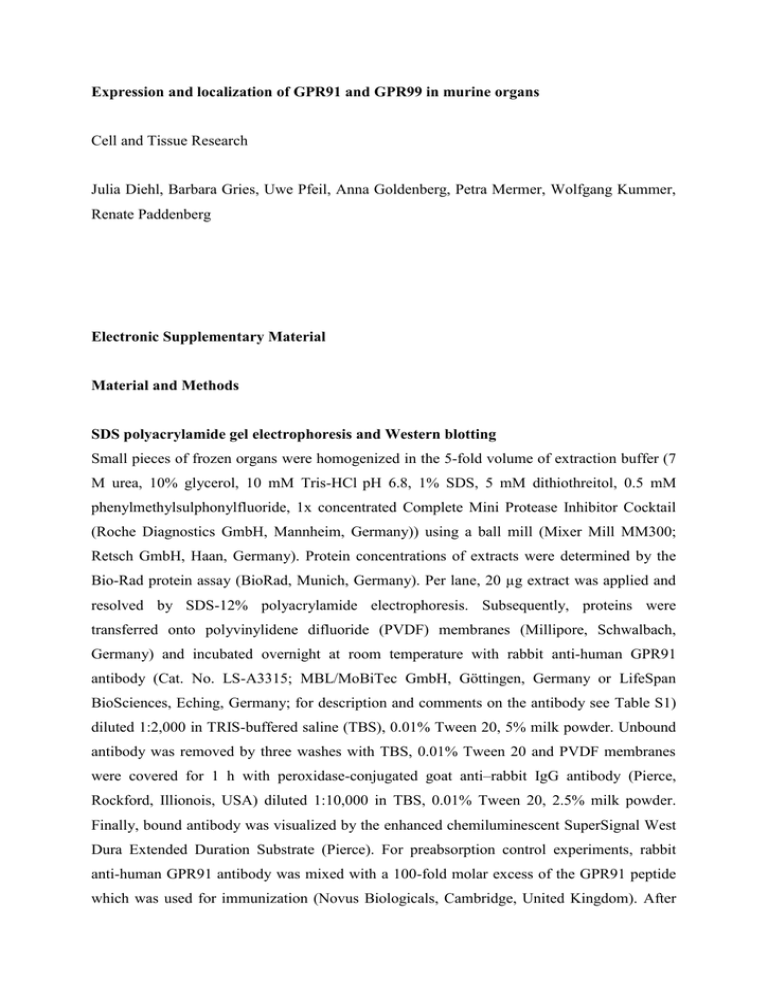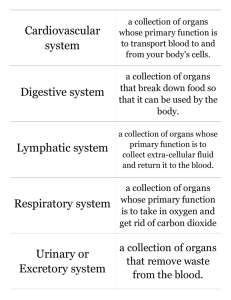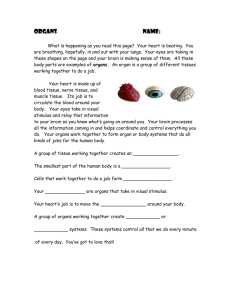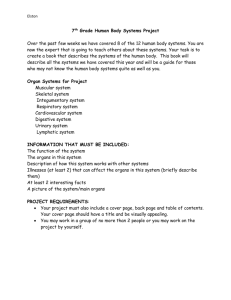Expression and localization of GPR91 and GPR99 in murine organs
advertisement

Expression and localization of GPR91 and GPR99 in murine organs Cell and Tissue Research Julia Diehl, Barbara Gries, Uwe Pfeil, Anna Goldenberg, Petra Mermer, Wolfgang Kummer, Renate Paddenberg Electronic Supplementary Material Material and Methods SDS polyacrylamide gel electrophoresis and Western blotting Small pieces of frozen organs were homogenized in the 5-fold volume of extraction buffer (7 M urea, 10% glycerol, 10 mM Tris-HCl pH 6.8, 1% SDS, 5 mM dithiothreitol, 0.5 mM phenylmethylsulphonylfluoride, 1x concentrated Complete Mini Protease Inhibitor Cocktail (Roche Diagnostics GmbH, Mannheim, Germany)) using a ball mill (Mixer Mill MM300; Retsch GmbH, Haan, Germany). Protein concentrations of extracts were determined by the Bio-Rad protein assay (BioRad, Munich, Germany). Per lane, 20 µg extract was applied and resolved by SDS-12% polyacrylamide electrophoresis. Subsequently, proteins were transferred onto polyvinylidene difluoride (PVDF) membranes (Millipore, Schwalbach, Germany) and incubated overnight at room temperature with rabbit anti-human GPR91 antibody (Cat. No. LS-A3315; MBL/MoBiTec GmbH, Göttingen, Germany or LifeSpan BioSciences, Eching, Germany; for description and comments on the antibody see Table S1) diluted 1:2,000 in TRIS-buffered saline (TBS), 0.01% Tween 20, 5% milk powder. Unbound antibody was removed by three washes with TBS, 0.01% Tween 20 and PVDF membranes were covered for 1 h with peroxidase-conjugated goat anti–rabbit IgG antibody (Pierce, Rockford, Illionois, USA) diluted 1:10,000 in TBS, 0.01% Tween 20, 2.5% milk powder. Finally, bound antibody was visualized by the enhanced chemiluminescent SuperSignal West Dura Extended Duration Substrate (Pierce). For preabsorption control experiments, rabbit anti-human GPR91 antibody was mixed with a 100-fold molar excess of the GPR91 peptide which was used for immunization (Novus Biologicals, Cambridge, United Kingdom). After 24 h incubation at 4°C, the antibody-peptide mixture was applied to the PVDF membrane as outlined above. For a densitometric evaluation of the signals, X-ray films were scanned and mean intensities of immunoreactive bands were calculated on a scale of grey values ranging from 0 to 255 using open-to-public software “ImageJ 1.37V”. For quantification of the amount of GPR91 protein in different organs, a sample of the same kidney extract was included in all western blots as reference. RNA isolation and RT-PCR Total RNA from most tissues was isolated using RNeasy mini kit (Qiagen, Hilden, Germany) according to manufacturer’s protocol. RNA from adipose tissue was isolated by phenolchloroform extraction using TRIzol reagent (Invitrogen, Darmstadt, Germany). Contaminating genomic DNA was degraded by treatment of total RNA (up to 1 µg) with 1U DNase I (Invitrogen) for 15 min at 25°C. Messenger RNA was reverse transcribed using SuperScript II RNase H- Reverse transcriptase (200 U/onset; Invitrogen) and oligo-dT18 (5 µM; MWG-Biotech, Ebersberg, Germany) as primer for 50 min at 42°C. For subsequent qualitative PCR, 2.5 µl buffer II (100 mM Tris-HCl, 500 mM KCl, pH 8.3), 2 µl MgCl2 (25 mM), 0.75 µl dNTP (10 mM each), 0.25 µl AmpliTaq Gold polymerase (5U/µl; all reagents from Applied Biosystems, Darmstadt, Germany), and 0.75 µl of each primer (200 µM; MWG-Biotech) were supplemented with water to a final volume of 25 µl. Cycling conditions included an initial denaturation at 95°C for 12 min, 40 cycles with 95°C for 20 s, 60°C for 20 s, 72°C for 20 s, and a final extension step at 72°C for 7 min. Real time RT-PCRs were done with IQ SYBR Green Supermix (Bio-Rad, Munich, Germany) in combination with the ICycler IQ detection system (Bio-Rad). Tissue preparation for immunohistochemistry Immunohistochemistry was performed on frozen sections and on paraffin-embedded tissues. For the preparation of frozen sections, mice were killed by inhalation of an overdose of isoflurane (Baxter) and exsanguinated by cutting of the abdominal aorta. Organs were dissected and transferred into Zamboni fixative (2% paraformaldehyde, 15% saturated picric acid in 0.1 M phosphate buffer, pH 7.4). After 6 h, the organs were rinsed in 0.1 M phosphate buffer and washed with increasing concentrations of sucrose (9% and 18% in 0.1 M phosphate buffer). Subsequently, the tissues were embedded in O.C.T.TM Compound (Tissue Tec; Sakura Finetek Europe B.V., Zoeterwoude, Netherlands) and frozen in liquid nitrogen. Frozen sections were cut at 10 µm and air-dried before staining. For preparation of paraffin sections, organs were fixed in situ by perfusion through the left ventricle with Zamboni fixative and submitted to further immersion fixation in Zamboni fixative for 6 h. After washing out the fixative, the organs were processed according to standard protocols. Finally, the organs were paraffin-embedded and serially sectioned at 6-8 µm. Sections were subjected to immunohistochemistry after deparaffination, rehydration and inhibition of endogenous peroxidase activity with 0.3% H2O2 in methanol. H&E staining Dried 10 µm thick frozen sections and 6-8 µm thick deparaffinized and rehydrated paraffin sections were used for H&E staining according to standard protocols. Briefly, sections were washed in H2O, stained for 1-10 min in Mayer's hemalaun stain (Cat. No 1.09249; Merck Chemicals GmbH, Darmstadt, Germany) diluted 1:2 and differentiated in running tap water for 10 min. After a short wash in H2O, sections were stained for 2-5 min with Eosin Y solution 0.5 % in water (Cat. No. X883.1; Carl Roth GmbH & Co. KG, Karlsruhe, Germany). Then, sections were washed in H2O, dehydrated in ascending alcohol baths followed by xylol and finally mounted in Eukitt Mounting Medium.






